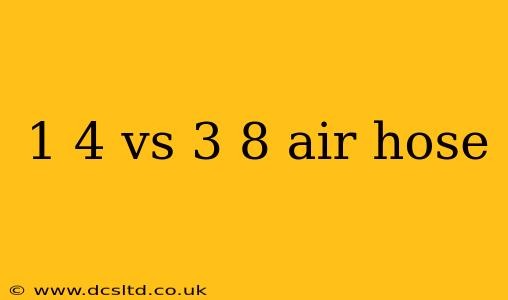Choosing the right air hose size is crucial for efficiency and safety in any application, whether you're a professional mechanic, a DIY enthusiast, or using an air compressor for home projects. The most common sizes you'll encounter are 1/4" and 3/8" inner diameter hoses. This guide will break down the key differences to help you choose the best option for your needs.
What are the key differences between 1/4" and 3/8" air hoses?
The most significant difference lies in the inner diameter, which directly impacts the airflow capacity. A 3/8" air hose has a larger inner diameter than a 1/4" hose, allowing for a greater volume of compressed air to flow through it. This translates to more power and faster operation for air tools.
What is the best air hose size for my needs?
The "best" size depends entirely on your specific application and the air tools you'll be using.
1/4" Air Hose:
- Ideal for: Lighter-duty applications, smaller air tools (like nail guns, spray guns, and detailers), and situations where portability and maneuverability are prioritized. These hoses are generally lighter, easier to coil, and less expensive.
- Pros: Lightweight, flexible, easier to store, less expensive.
- Cons: Lower airflow capacity, may not be suitable for high-demand air tools.
3/8" Air Hose:
- Ideal for: Heavy-duty applications, larger air tools (like impact wrenches, sandblasters, and larger spray guns), and situations where high airflow is required for optimal performance.
- Pros: Higher airflow capacity, suitable for powerful air tools, improved performance with demanding tasks.
- Cons: Heavier, less flexible, more expensive, and takes up more storage space.
How does hose length affect performance?
Regardless of the diameter, the length of the air hose also affects performance. Longer hoses lead to increased pressure drop, meaning less air pressure reaches your tools. This is especially noticeable with smaller diameter hoses. If you need a long hose, consider using a larger diameter hose (3/8") to minimize pressure loss.
What about hose materials and construction?
While diameter is a crucial factor, don't overlook the hose material and construction. Look for hoses made from durable materials like polyurethane or reinforced rubber that can withstand the pressures and abrasion of regular use. Reinforced hoses are less prone to kinks and damage.
What type of fittings should I consider?
Ensure the fittings on the air hose are compatible with your air compressor and tools. Common fittings include quick-connect couplings for easy attachment and detachment.
What are the common applications for each hose size?
- 1/4" Hose: Ideal for automotive detailing, hobbyist use, light-duty pneumatic tools in workshops, and smaller pneumatic tools on construction sites.
- 3/8" Hose: Best suited for professional use, heavy-duty pneumatic tools, industrial applications, and tasks demanding high airflow capacity.
How do I choose the best air hose for my air compressor?
Consider your air compressor's output capacity. A more powerful compressor may justify a 3/8" hose to fully utilize its potential. Check your air compressor's manual for recommendations on appropriate hose sizes.
By carefully considering your specific needs and the factors outlined above, you can choose the right air hose—whether 1/4" or 3/8"—to ensure efficient and safe operation of your air tools.
